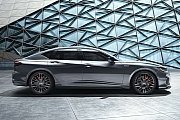history
The Japanese seem to have all the traits of engineering-passionate mythical phoenix birds descendants. After having risen from the ashes of the Hiroshima and Nagasaki Second World War nuclear bombings, the island dwellers leaped into a full-scale both intrinsic and outer reconstruction process that would later catapult them as a leading force on the international auto-market. 1986 was the year when Japanese engineers unleashed their newly formed Acura division of 4 wheeled katanas against the frail armies of western technology.
Soon after the attack was initiated, early models of Acura vehicles quickly took over vast US car market shares on the road to victory. The spark triggered a mass techno-religious conversion among car buyers who quickly turned to the new Eastern alternatives - who have accurately hit the niche American builders had failed to fill: the luxury market.
Acura was born as the rich child of the elder Honda father-brand and quickly became the driving force that would change customers' perception of Asian motorized artisanship. The package Acura delivered to the US after Honda had spent 10 ears of research consisted of only two models: the Legend and the Integra. The road-runner pair had enough success overseas to compel competing Asian brands into sending their own troops to the US. Thus, Toyota sent a wave of hostile novelty and improvements with their newly created luxurious Lexus brigade and Nissan joined the party by flaunting a new shiny infant-brand, the Infiniti.
Although Acura had already managed to integrate the legend of better Asian automobiles into US consumer minds through the V6-powered Legend sedan and the sleek, sharp Integra, it was yet to display all of its arsenal. As soon as the 90's came, four years after the brand had reached American territory, it delivered a crushing blow to luxurious-sports car competitors: the NSX. An acronym for a science-fueled battle cry that translated as 'New Sports eXperimental', the NSX quickly became a cheaper and fun alternative to costly European counterparts such as the ones delivered by German and Italian manufacturers like BMW and road-cruising and racing supremacists Ferrari.
Not only did the NSX strike a weak spot, but it also garnered appreciation as being the first series car made entirely of aluminum. Despite its early success, Acura entered some mid 90's dark ages as a result of reported poor design choices and failure to rejuvenate the already existing line of models. By 1996, the Legend and Integra names were dropped and replaced with parsimonious alphanumeric tags as part of a new naming nomenclature that would drag the entire brand to a mild maelstrom of confusion. Subsequent model improvements and quasi-subtle Lexus design forgery plunged Acura into temporary platitude, despite its engine power upgrades to more than 200 hp on 1996's 3.5 RL - the reinvented Legend.
The knockdown effect would not last for long though, as the beginning of the 21st century brought Acura to a fresh start with the introduction of several redesigned models, such as the 1999 Acura 3.2 TL, engineered as a challenger against competition's wheeler-troopers, such as the Lexus ES, Infiniti l30 and the the BMW 3-series. Despite having failed to dominate its foes, the 3.2 earned much acclaim due to its consumer attractiveness that was the result of a balanced blend of luxury, sportiness and competitive pricing.
In a matter of years, Acura took on SUV territory with the MDX and continued to sustain the rise of its machines with new accomplishments and faster, better units at the exiting factory gates. In fact, Acura is currently leading a full-scale take-over, with the brand having reached Chinese markets only two years ago and plans for breaking into the former USSR compound by the end of 2008.
expand




















